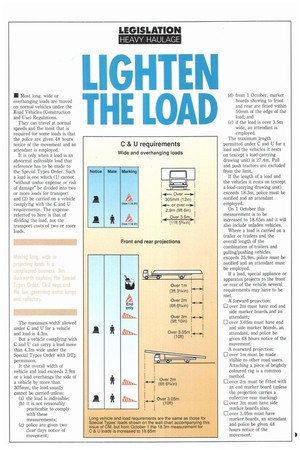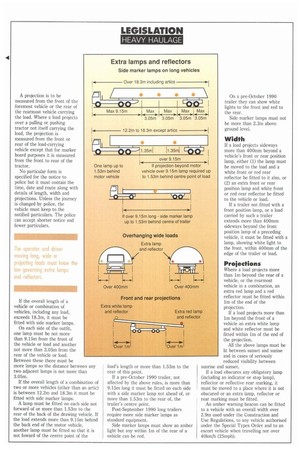LIGHTEN
Page 34

Page 36

If you've noticed an error in this article please click here to report it so we can fix it.
THE LOAD
• Most long, wide or overhanging loads are moved on normal vehicles under the Road Vehicles (Construction and Use) Regulations.
They can travel at normal speeds and the most that is required for some loads is that the police are given 48 hours notice of the movement and an attendant is employed.
It is only when a load is an abnormal indivisible load that reference has to be made to the Special Types Order. Such a load is one which (1) cannot "without undue expense or risk of damage" be divided into two or more loads for transport and (2) be carried on a vehicle complying with the C and U requirements. The expense referred to here is that of dividing the load, not the transport costs of two or more loads.
The maximum width allowed under C and U for a vehicle and load is 4.3m.
But a vehicle complying with C and U can carry a load more than 4.3m wide under the Special Types Order with Dip permission.
It the overall width of vehicle and load exceeds 2.9m or a load overhangs the side of a vehicle by more than 305mm, the load usually cannot be carried unless: (a) the load is indivisible; (b) it is not reasonably practicable to comply with these measurements; (c) police are given two clear days notice of movement; (d) from 1 October, marker boards showing to front and rear are fitted within 50mm of the edge of the load; and (e) if the load is over 3.5m wide, an attendant is employed.
The maximum length permitted under C and U for a load and the vehicles it rests on (except a load-carrying drawing unit) is 27.4m. Pull and push tractors are excluded from the limit.
If the length of a load and the vehicles it rests on (except a load-carrying drawing unit) exceeds 18.3m, police must be notified and an attendant employed.
On 1 October this measurement is to be increased to 18.65m and it will also include unladen vehicles.
Where a load is carried on a trailer or trailers and the overall length of the combination of trailers and pulling/pushing vehicles exceeds 25.9m, police must be notified and an attendant must be employed.
If a load, special appliance or apparatus projects to the front or rear of the vehicle several requirements may have to be met.
A forward projection: Li over 2m must have end and side marker boards and an attendant; El over 3.05m must have end and side marker boards, an attendant, and police be given 48 hours notice of the movement.
A rearward projection:
CI over lm must be made visible to other road users. Attaching a piece of brightly coloured rag is a common method.
Dover 2m must be fitted with an end marker board (unless the projection carries a reflective rear marking) ID over 3m must have side marker boards also;
CI over 3.05m must have marker boards, an attendant and police be given 48 hours notice of the movement.
A projection is to be measured from the front of the foremost vehicle or the rear of the rearmost vehicle carrying the load. Where a load projects over a pulling or pushing tractor not itself carrying the load, the projection is measured from the front or rear of the load-carrying vehicle except that for marker board purposes it is measured from the front to rear of the tractor.
No particular form is specified for the notice to police but it must contain the time, date and route along with details of length, width and projections. Unless the journey is changed by police, the vehicle must keep to the notified particulars_ The police can accept shorter notice and fewer particulars.
If the overall length of a vehicle or combination of vehicles, including any load, exceeds 18.3m, it must be fitted with side marker lamps.
On each side of the outfit, one lamp must be not more than 9.15m from the front of the vehicle or load and another not more than 3.05m from the rear of the vehicle or load. Between these there must be more lamps so the distance between any two adjacent lamps is not more than 3.05m.
If the overall length of a combination of two or more vehicles (other than an attic) is between 12.2m and 18.3m it must be fitted with side marker lamps.
A lamp must be fitted on each side not forward of or more than 1.53m to the rear of the back of the drawing vehicle. If the load extends more than 9.15m behind the back end of the motor vehicle, another lamp must be fitted so that it is not foward of the centre point of the
load's length or more than 1.53m to the rear of this point.
If a pre-October 1990 trailer, not affected by the above rules, is more than 9.15m long it must be fitted on each side with a side marker lamp not ahead of, or more than 1.53m to the rear of, the trailer's centre point.
Post-September 1990 long trailers require more side marker lamps as standard equipment.
Side marker lamps must show an amber light but any within lm of the rear of a vehicle can be red. On a pre-October 1990 trailer they can show white lights to the front and red to the rear.
Side marker lamps must not be more than 2.3m above ground level.
Width
If a load projects sideways more than 400mm beyond a vehicle's front or rear position lamp, either (1) the lamp must be moved to the load and a white front or red rear reflector be fitted to it also, or (2) an extra front or rear position lamp and white front or red rear reflector be fitted to the vehicle or load.
If a trailer not fitted with a front position lamp, or a load carried by such a trailer extends more than 400mm sideways beyond the front position lamp of a preceding vehicle, it must be fitted with a lamp, showing white light to the front, within 400mm of the edge of the trailer or load.
Projections
Where a load projects more than lm beyond the rear of a vehicle, or the rearmost vehicle in a combination, an extra red lamp and a red reflector must be fitted within lm of the end of the projection.
If a load projects more than lm beyond the front of a vehicle an extra white lamp and white reflector must be fitted within lm of the end of the projection.
414111....
All the above lamps must be lit between sunset and sunise and in cases of seriously reduced visibility between sunrise and sunset.
If a load obscures any obligatory lamp (including an indicator or stop lamp), reflector or reflective rear marking, it must be moved to a place where it is not obscured or an extra lamp, reflector or rear marking must be fitted.
An amber warning beacon can be fitted to a vehicle with an overall width over 2.9m used under the Construction and Use Regulations, to any vehicle authorised under the Special Types Order and to an escort vehicle when travelling not over 40km/h (25mph).




















































































































